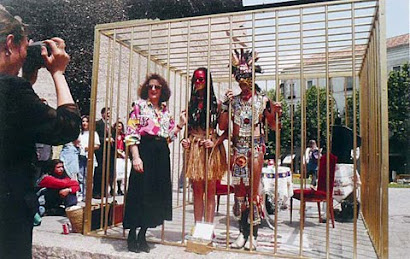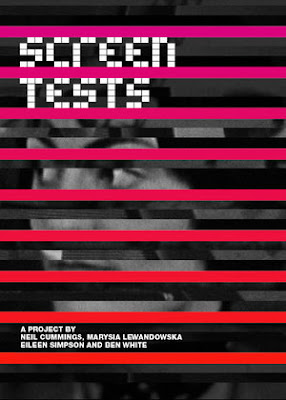

Mierle Laderman Ukeles
"Maintenance Art Performance Series", 1973-74
Photograph of performance at the Wadsworth Atheneum.
Courtesy of the Ronald Feldman Gallery, New York.
Cyrus Smith posted this on the Art Talk on the Radio when she came for a visit:
After child-birth in 1968, artist Mierle Laderman Ukeles became a mother/maintenance worker and fell out of the picture of the avant-garde. In a rage, she wrote the Manifesto for Maintenance Art 1969, applied equally to the home, all kinds of service work, the urban environment, and the sustenance of the earth itself. Inspired, also, by NYC’s “Comprehensive Plan” that split its mission into two systems: development and maintenance, she has created works that collide the boundaries of these two systems together, understanding them as the embodiment of opposing human drives of freedom and necessity. Upcoming and recent exhibitions are Birthing Tikkun Olam, an inter-active installation where over 8,000 people participated in completing the work at the new Contemporary Jewish Museum in San Francisco; Radical Nature at the Barbican in London; Agency: the Work of Artists at the Montalvo Art Center, San Jose; a one person show in the Feldman Gallery Booth at the International Armory Art Fair in NYC; WACK! Art & the Feminist Revolution beginning at the Los Angeles Museum of Contemporary Art and traveling; and the Sharjah Biennial 8, United Arab Emirates. Often a visiting artist, she was Senior Critic at Yale in the sculpture department in 2007—2008. Forthcoming and recent publications include “Forgiveness for the Land: Public Offerings Made by All, Redeemed by All,” in On Forgiveness, the List Center for Art and Politics, NYC, 2009; and “The Power of the Artist & The Power of Art in the Public Domain,” in Creative Time: The Book, 2007.
AND HERE IS A LETTER SHE WROTE IN 'Letters to a Young Artist'
Mierle Laderman Ukeles, 'Transfer: The Maintenance of the Art Object', 1974
Dear Young Artist,
I, as you, have put off writing to you, because I am not seeing you in person to gauge your responses to what I say. Would you blink, blinking back some fear or embarrassment you might not want to expose, if I say this or that? If I were facing you, I could change my direction, make space more real or possible for you in what I say. In a letter, you are a "Young Artist" in the abstract. I am worrying about your uniqueness, about not honoring your uniqueness. Are your sensibilities rawly close to the surface or protected by a fresh urban armor? Will you have any clue what I am talking about? Can this be a good and helpful thing for you or a stumbling block? But we're stuck on paper; so here goes.
I believe that art is the articulation of human freedom. Remember, above all, you are the boss, The Boss, of your freedom. No one else. Your art, if it is original and worth something, expands all human freedom.
Art, after it comes through you, will be different. Art comes from you, you all by yourself, unique among anyone who has ever lived in the history of the world; AND, art comes from you in your world with the choices you make as a free being, and the glue, even. With the relationships that you create and stick to; AND art comes from you as a citizen in the world; AND you within history and in nature.
It is your job to re-invent art itself, through what you create.
This is not the job of critics, theorists, and curators. They follow. We lead, shape, and bend the path of history.
I'm not saying throw out history. But the main history we work from is from artist to artist: handed down. Actually, to save your neck, you can learn to talk to artists, even those from hundreds and thousands of years ago: Bring them your problems, your terrors, your dreams, practical things you have to solve.
You don't have to shape up to someone else's definition of "the artist." Make it up, make up the whole thing, while you're doing what you have to do to survive. You are even free to open yourself up to survival and maintenance of your choices as fountains of your art; you can let these tough customers flow through you.
You worry about showing too early. I disagree. Because you will change, become a new person, many many times over through the years. You will re-invent yourself out of your circumstances and your will. If you show later, you're someone else. Showing can keep a kind of integrity to who you are at the moment.
I used to worry about that when I was young. I actually thought I would keep silent for ten years before I opened my mouth about anything. Now I think that's ridiculous. I was a certain kind of spirit then, and a different one ten years later. Shmushing your young spirit into a more "mature" spirit is being violent to oneself as one is through time.
You ask about the art world and worry about it corrupting you. First of all, you only mention galleries in relation to the art world. You don't mention the streets, the water, the air, the land, below the land. You don't mention cities, urbanism. You don't mention outer space, inner space, multiple scales, microscopic scales. WHAT? You don't mention the public domain, democracy, the meaning of public.
You don't mention the people who receive or who could enter into direct relationship, even interactive relationship, with your art.
You don't mention changing the world itself, bursting all categories, starting over, re-inventing everything. WHAT?
You can see here that I come from the 1960s and 70s. It's so obvious.
So I think the "Art World" is a much more huge entity than you mention. It's way bigger than galleries.
BUT, I cherish the art world. The whole art world. It can be cruel, cold, indifferent; but it is also a world that you can shape. That's where there are people who can listen to you at the deepest level, more than anyone. People who can come across you -- even people that you may never meet -- and who will make it possible for you to keep believing in your own struggle, even if you become desperate. They are at the essence of the enterprise of making and continuing to make until you have no more breath to breathe! It is the art world that has kept art going from eons ago, responsible to art as if it were one's own child.
So I wish you a long life and great courage. Believe in yourself and work your ass off.
Mierle Laderman Ukeles
New York















































